Along with the choice of guitar and amplifier, a guitarist’s pedalboard is one of the most important factors when it comes to creating your sound. Effects pedals provide you with sonic options that can completely transform the tone of your guitar. Regardless of the genre or style of guitar you play, a delay pedal is a highly useful addition to your overall setup.
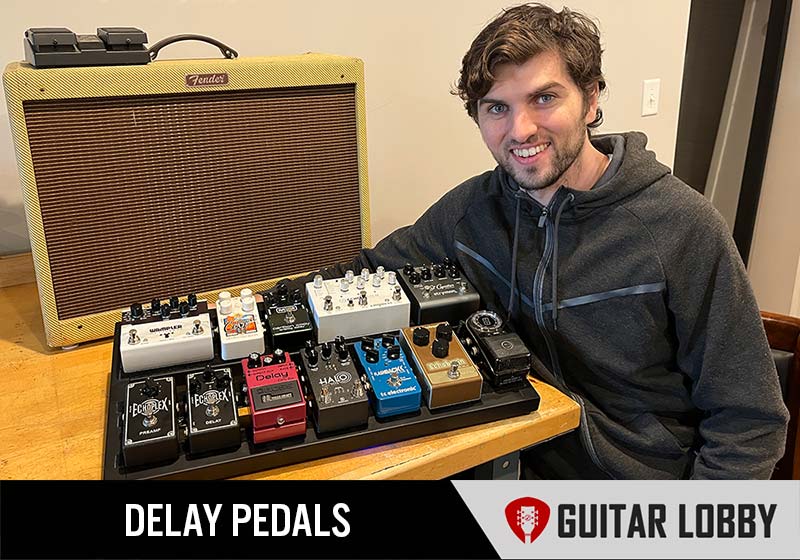
The issue many guitarists face when choosing a delay pedal is that the sheer number of options out there can be overwhelming. There are so many high quality delay pedals with differing attributes that it can be difficult to know where to start. In this comprehensive guide, I will begin by reviewing the best delay pedal at each price point. If you would like more information on these pedals before reading reviews, you can check out our delay pedal information guide at the bottom of the page here.
Here Are the Best Delay Pedals (All Price Ranges)
1. MXR-M169 Carbon Copy Analog Delay (Best Analog)

| Estimated Price | $150 |
| Type | Analog |
| Max Delay Time | 600 Ms |
| Effects | Delay, Modulation |
| Connectivity | 1 x 6.35mm Jack Input, 1 x Output |
| Power | 9 Volts DC |
The MXR Carbon Copy is one of my all-time favorite delay pedals. It’s an excellent option for those who prefer the full-bodied warmth of analog delay to the modern digital delay that is popular today.
I personally love using an analog delay for a subtle delay effect that thickens up my sound, and I find the Carbon Copy serves that purpose brilliantly. At the same time, the 600ms of delay time this pedal offers is more than enough for me to create an array of vintage guitar tones with more distinctive echo effects. I also find the top-mounted modulation switch very useful, as it provides an instantaneous and simple way to make my guitar tone stand out in the mix. The classic, straightforward three-knob layout makes the Carbon Copy very easy to use, but the simple design can be deceptive. I’ve spent many hours experimenting with my tone using this delay pedal, and I’m often amazed by how much tonal and dynamic versatility it boasts despite its seemingly minimalistic control layout!
Something I feel sets the MXR Carbon Copy apart from the competition is its two internal trim pots. I like that this allows me the ability to adjust the rate and width of the built-in modulation, making the Carbon Copy a dual-effects pedal. This creates a seemingly limitless number of possibilities to create my own unique delay sounds with relative ease.
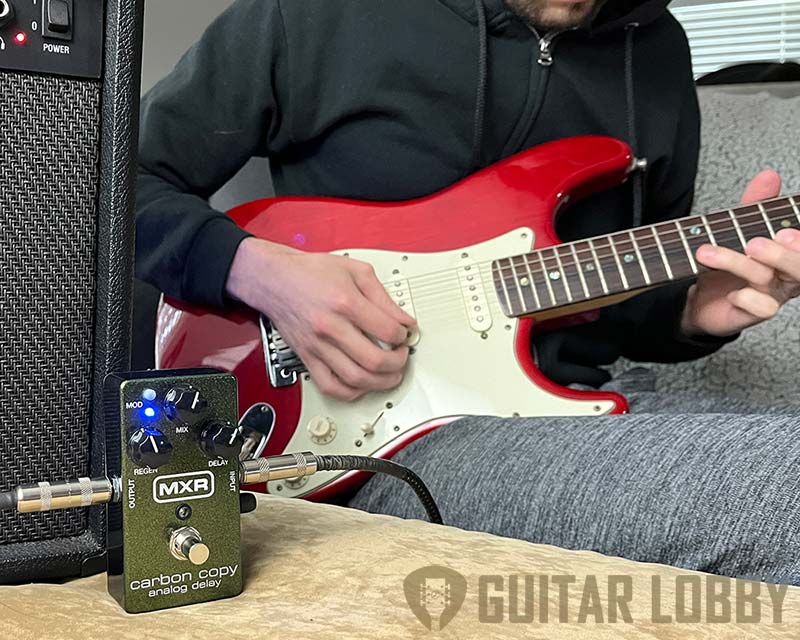
My favorite way to use the Carbon Copy is to combine it with some gain in the form of a distortion or overdrive pedal. With the right amount of saturation, this pedal sounds huge, particularly when it is played through my Fender tube amp! I like to increase the gain on my overdrive pedal slightly, then tweak the Delay and Regen knobs on this MXR stompbox until I find the right blend of grit and smoothness to suit the style of song I’m playing. I’ve also had success using the Carbon Copy when going directly into an audio interface preamp for recording rather than using an amplifier. Its analog design ensures that the delay doesn’t sound artificial and complements the clean tone of a direct recording very nicely.
Another reason this pedal has been a staple of my effects chain since I first used it is because of its compact physical design. Unlike many modern delay pedals that are bulky and complex, the Carbon Copy takes up hardly any space on my pedalboard. On the whole, guitarists searching for that elusive Gilmour-inspired delay sound will, in my opinion, love the MXR Carbon Copy. It blends a natural, authentic tone with impressive versatility, so it would be a worthy acquisition for any guitarist who loves that old-school, inviting warmth of analog delay.
Bottom Line: At under $150, this classic analog delay pedal is a bargain, in my opinion. Not only will it help you to thicken up your sound on stage, but it’s also a handy tool in the studio. Recording with the Carbon copy straight into a direct output produces some excellent results, as does use with a tube amplifier. I’d say it’s the best analog delay pedal for most people.
Popular Related Article: Top 17 Reverb Pedals
2. Wampler Metaverse (Editor’s Choice)
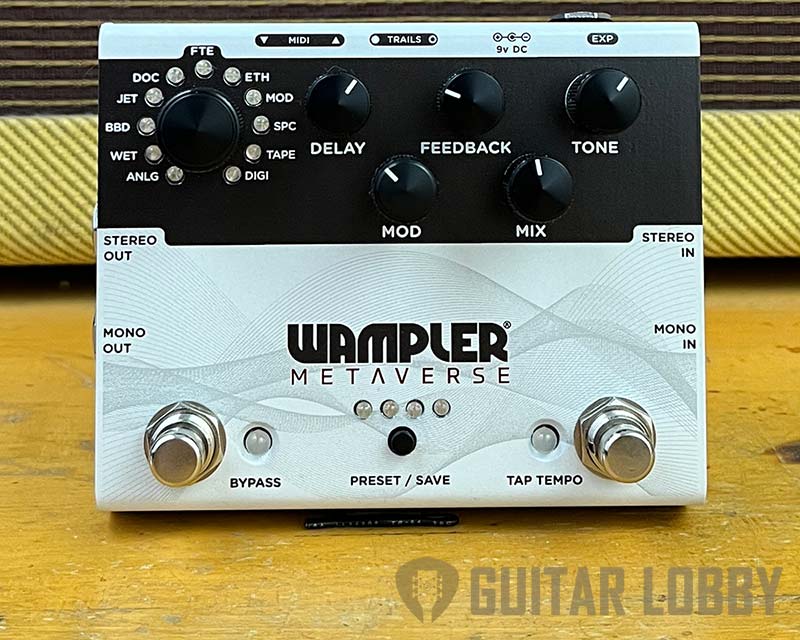
| Estimated Price | $300 |
| Type | Digital |
| Max Delay Time | 2000ms |
| Effects | Delay |
| Connectivity | 2 x 6.35mm Jack Input, 2 x Output |
| Power | 9 Volts DC |
When I first heard about the Wampler Metaverse, I was expecting an innovative, slightly futuristic delay pedal – and that’s exactly what I got. This device is a tool that I often use when recording electric guitar, as the quality it produces is better than the majority of VST plugins and effects included in DAWs. There are many ways that I like to use this pedal, but one of my favorite tricks is to use the onboard tap tempo footswitch to match the repeated signals to the groove of a live rhythm section or backing track, then crank up the Feedback gradually while holding a single note or chord on the guitar. This creates a pulsating, synth-like sound that most delay pedals are incapable of producing and is an excellent way to build tension during a breakdown section before a heavier part kicks in.
When switching between the 11 onboard presets, I could tell that a lot of attention to detail had been applied by Wampler when designing this pedal. I’m particularly fond of the “Jet” preset, which adds a flanger-style effect to the delay tails and is excellent for classic rock solos. The Metaverse impressed me with its ability to blend modulation with delay – it proves that flangers can work with timing-based effects without becoming too chaotic or unpredictable. I like to use the pedal in stereo mode when recording directly into my audio interface, producing a thick, consistent sound that highlights the effects’ details. However, using the mono mode and running the pedal into my amp’s effects loop is a great alternative when playing live.
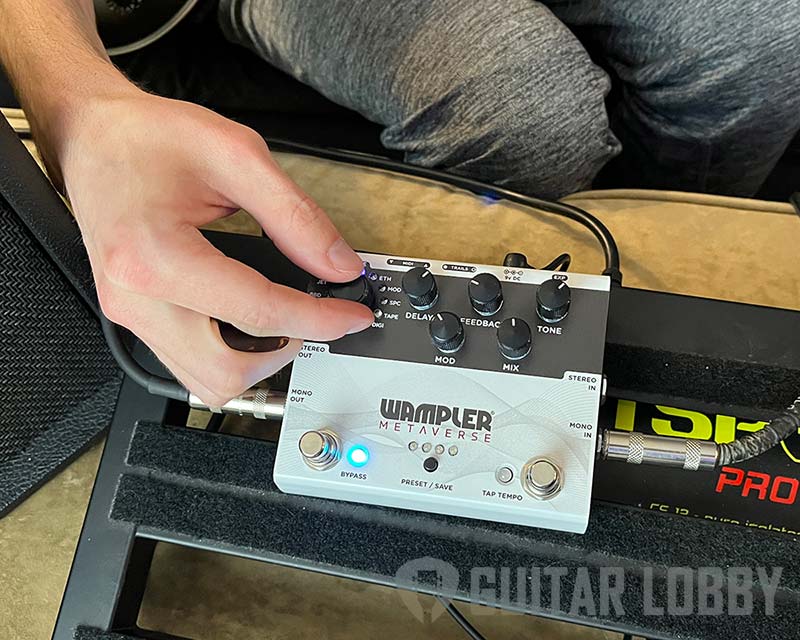
The “Ethereal Delay” preset is another that is worth mentioning. It produces a dreamy, captivating effect that sounds incredible when you play fast, percussive guitar parts. If you want to transform your guitar into an otherworldly instrument, crank up the “Mod” and “Feedback” controls while using this preset – you won’t be disappointed! I also like that the pedal offers eight slots to save any presets that I create when tweaking the six onboard controls. I find it’s worth taking the time to gradually adjust the Delay, Feedback, Tone, Mod, and Mix knobs until you find the ideal sound, then saving them to one of the slots for instant recall whenever you need that sound. I’d highly recommend the Metaverse to musicians who frequently switch styles for performances or recordings – this pedal is an excellent shapeshifter!
Bottom Line: Boasting versatility and excellent sound quality, the Wampler Metaverse gives you everything you could possibly need from a digital delay pedal. Due to this device’s vast range of capabilities, it might be more accurate to describe it as a multi-effects pedal!
3. Keeley Halo Dual Echo
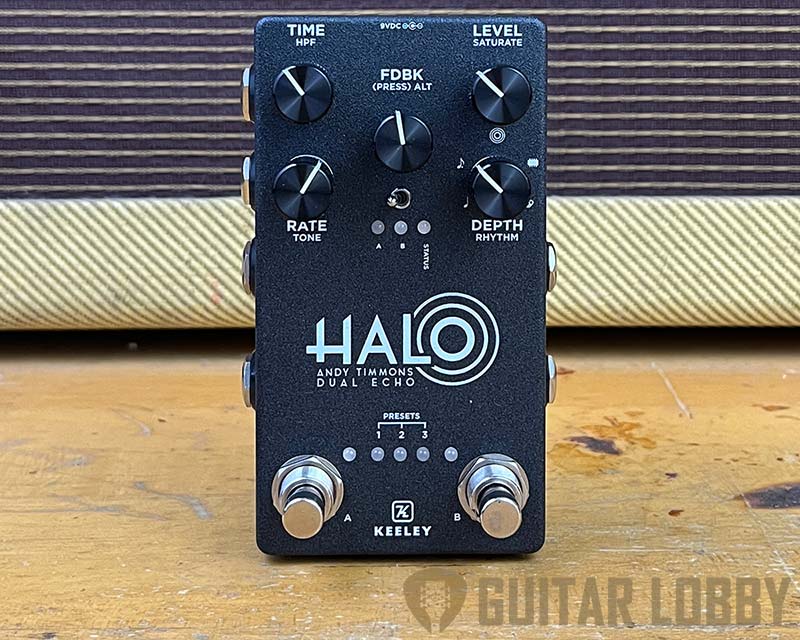
| Estimated Price | $300 |
| Type | Digital |
| Max Delay Time | 1.5 seconds |
| Effects | Delay |
| Connectivity | 2 x 6.35mm Jack Input, 2 x Output |
| Power | 9 Volts DC |
The Keeley Halo Dual Echo is an advanced delay stompbox I’ve used frequently for the past few months. Its ability to blend seamlessly with my other pedals is down to Keeley’s design and circuitry quality. It looks like a boutique analog delay, but when I first used the pedal, I was a little surprised to discover that it is, in fact, fully digital. My favorite feature of this pedal is the ability to switch between the two main presets – Side A and Side B, which I find is basically like having two different delay pedals in one housing. I like using side A as my primary delay effect, setting the rotary controls to roughly the center and then saving it as a basic preset. I use Side B for my more experimental delay tones, setting the Rate and Depth controls around 75% to achieve a dramatic, otherworldly sound.
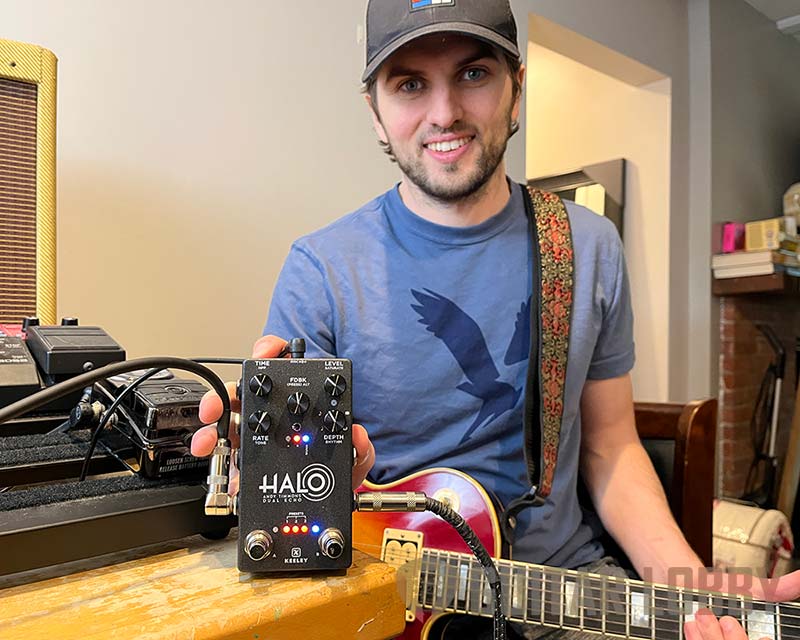
The Halo Dual Echo is based on the iconic effect that was designed by Andy Timmons, and Wampler has successfully converted it into a conveniently sized stompbox. It boasts a tap tempo feature, thanks to the Smart Stomp System, and I also find this useful when creating infinite repeats with my guitar via the alternative stomp switch. I also like to hook my expression pedal up to the Halo to give me further control over whichever parameter I assign it to.
Bottom Line: This Keeley delay pedal is great value for money, as it essentially gives you two pedals in one! It’s very easy to customize the controls in order to achieve your desired delay effect. You can then save them to the user-preset slots to access them whenever required. With the legendary build quality of Keeley-designed pedals, there’s no chance of this device buckling under pressure.
4. Dunlop EP103 Echoplex
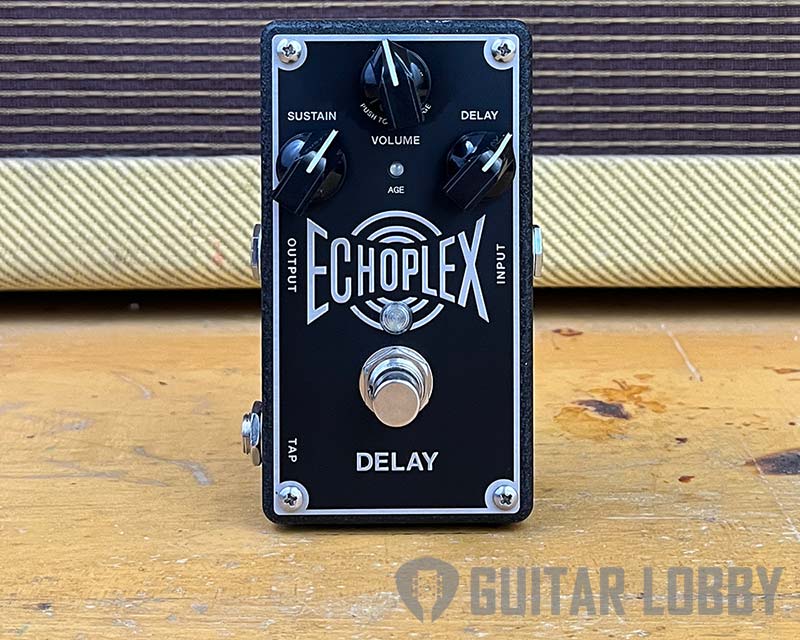
| Estimated Price | $200 |
| Type | Digital |
| Max Delay Time | 750 ms |
| Effects | Delay, Modulation |
| Connectivity | 1 x 6.35mm Jack Input, 1 x Output |
| Power | 9 Volts DC |
Known for their range of top-quality effects pedals, Dunlop has created one of my favorite digital delay stompboxes with the EP103 Echoplex. I must admit I have a slight obsession with vintage analog tape delay units like the Echoplex EP-3, and I was therefore excited to learn that it is inspired by the revolutionary late 1950s device in a smaller, more compact, and modernized format. I suspect that some will be skeptical of how effectively that legendary analog delay system can be transformed into a digital pedal, but somehow Dunlop has managed to pull it off!
I’m hesitant to categorize this pedal with other digital delay stompboxes, as it uses a fully analog dry path to make sure the much-loved tones of the EP-3 are still prevalent. I was highly impressed by the way that the high-quality digital path used for the wet signal provides you with the best of both worlds – analog warmth and digital versatility. The age control is one of the most unique features of the EP103 Echoplex. I’d never heard of a control with this label for testing this pedal, but when I pushed the Volume knob down, I was able to use this feature to sculpt a variety of delay tones, ranging from sparkling clarity to dark and chaotic.
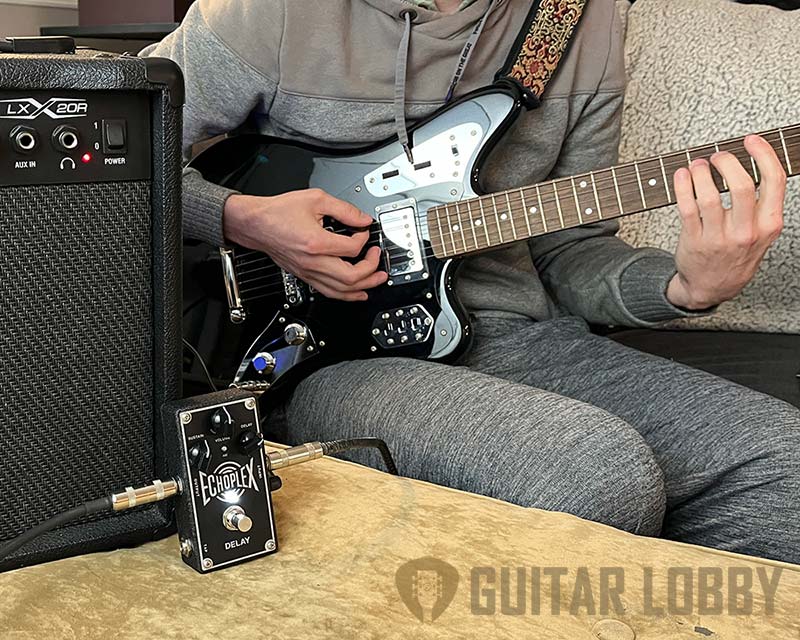
The delay time ranges between 65-750ms, and the low noise floor makes this a great option for recording. This delay pedal also has tap tempo capabilities, which I found very useful when using it alongside some of my modulation pedals, notably my phaser and flanger. Having control over the timing of the repeated signals makes it easy for me to stay in time with other musicians, particularly when we’re not playing along to a metronome.
The Echoplex is the perfect middle ground if you are torn between analog and digital delay sounds. I’ve found that this pedal can create understated delay effects or more transformative sounds that suit experimental styles without being overcomplicated to operate. If you intend to use your delay pedal for recording, this is an awesome option for the studio due to its low noise output. I’d also recommend it to people who use a lot of modulation effects in their signal chain, as it blends effortlessly with my other pedals.
Bottom Line: It’s rare that such versatility can be found on a small delay pedal without it becoming confusing and overcrowded. The Echoplex looks simplistic, but in reality, it’s brimming with sound-altering functions that suit a variety of styles and purposes. This is easily one of the best digital delay pedals for the money.
Popular Related Article: Recommended Cheap Electric Guitars
5. Empress Effects Echosystem
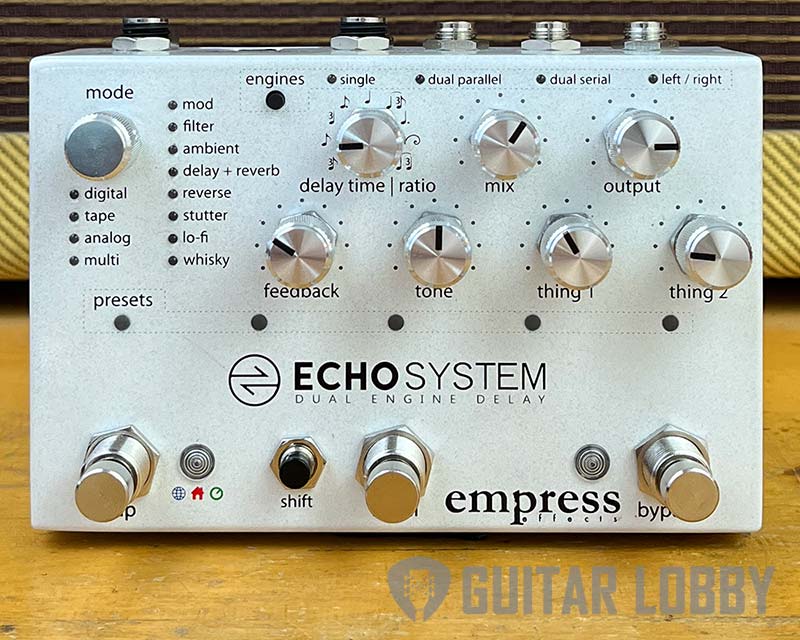
| Estimated Price | $500 |
| Type | Digital |
| Max Delay Time | 1.2 seconds |
| Effects | Delay |
| Connectivity | 2 x 6.35mm Jack Input, 2 x Output |
| Power | 9 Volts DC |
The Echosystem delay pedal intrigued me with its unique design before I even plugged my guitar into it. The first thing I noticed were some rather interestingly named controls such as “whisky”, “thing 1” and “thing 2”. I was fully prepared for this pedal to have a learning curve operate due to the array of controls it brandishes. Although a Delay machine like this took longer to become familiar with than some of the much simpler designed delay stompboxes we’ve covered in this guide, the feeling-out process was well worth it to experience the incredible versatility of this Empress delay pedal.
After countless hours experimenting with the Echosystem, I’ve found that the most interesting aspect of this delay pedal is the excellent “ambient” preset. When using this delay type, I like to start with all the rotary controls set halfway, with the single-engine setting selected. Then, by adjusting the “thing 1” and “thing 2” controls, I can create a diverse range of dreamy tones ideal for playing atmospheric music. “Thing 1” alters to the rhythmic pattern of the effect, while “thing 2” changes the diffusion, and you can create some exceptional ambient sounds by playing around with different combinations of settings.
Another effective way to use this pedal is by using the dual-engine modes to combine different delay presets. The dual delay engine is an invaluable tool if I’m looking for a unique tone, perhaps for an intro to a song or for some interesting subtle sounds to accompany vocals. The “dual serial” setting creates a balanced blend of your two chosen presets, or you can choose the “left/right” setting to pan each preset to a different channel. I’ve found that using the “reverse” preset with one of the more conventional forms of delay can enhance even the simplest riffs and melodies, and I love the sound of the “lo-fi” combined with the “delay+reverb” preset when playing chords.
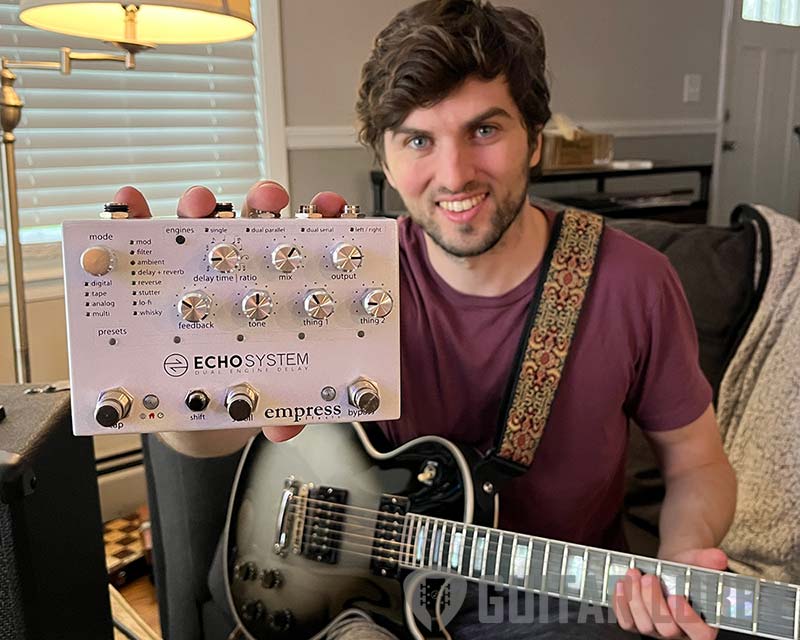
You can do so much with this pedal by utilizing the 12 main algorithm types. Some of the other standout presets include an authentic emulation of tape delay and an interesting filter delay. Once I’ve decided on the main setting, I like to play around with the alternate voicings, which offer different flavors of the 12 delay types – taking the total number of presets up to 42!
Due to the customizable nature of the Echosystem, I really enjoy taking the time to shape every aspect of the delay effect, then saving the settings to one of the 35 user preset slots. The navigation of these presets couldn’t be more straightforward, and I like to group several presets together so that I can quickly access them during a live performance or a recording session. Another aspect of this pedal that sets it apart is its extensive connectivity. There are two inputs and outputs, which make integrating the pedal into your signal chain easy, and there’s also a control port for tap tempo.
Bottom Line: The Echosystem is one of the most comprehensive digital delay pedals available to guitarists. It houses a huge range of sounds inspired by vintage outboard gear and more modern incarnations of the delay effect. While it’s more complicated to use than many simple digital delay stompboxes, the benefits it offers make the learning process worthwhile.
6. TC Echobrain
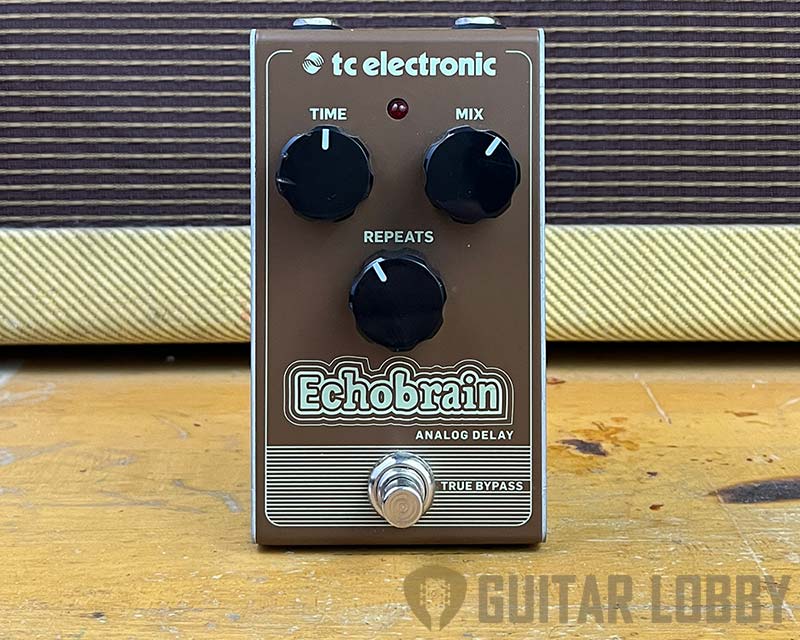
| Estimated Price | $70 |
| Type | Analog |
| Max Delay Time | 300ms |
| Effects | Delay |
| Connectivity | 1 x 6.35mm Jack Input, 1 x Output |
| Power | 9 Volts DC9 Volts DC |
I had a lot of experience with this compact analog delay pedal as I’ve owned one for years! Every time I use it, this pedal serves as a reminder to me that you don’t always need expensive and feature-packed gear to dial in a tone that is truly great. I’m always impressed by the impact this simple 3-knob pedal makes for my setup. Specifically, I tend to use this pedal to thicken each note by dialing in a very subtle delay with the delay time set somewhere right around the 8-oclock position, give or take until I hit a good spot that doesn’t quite produce 2 distinct notes to the ear, but rather sound like one fatter note. I like to keep repeats to just 2-3 and subtle with the mix aswell, usually around the 8-10 o’clock position somewhere. Once I’m happy with the settings, I will typically leave this delay pedal on 100% of the time. The bucket-brigade analog circuitry used by TC Electronic may not be as sophisticated as some of the circuitry used in more complex pedals like the aforementioned Echosystem, but what it lacks in terms of complexity, it makes up for in reliability.
With a delay time ranging from 40ms-300ms, I like to use this pedal for a shorter, slapback-style delay. It sounds great when I add some crunch to the signal with a fuzz or overdrive pedal, then set the Time control to around halfway, and play some classic rock chord sequences. Alternatively, I’ve found this pedal useful when creating intentional feedback loops or high-pitched drones by cranking the Repeats knob up.
Due to its simplicity and durability, I’d highly recommend this stompbox to any guitarist who wants access to high-quality delay without the complications that often come with advanced digital devices. It’s a very affordable pedal, and I like to use it as part of my reduced-sized effects chain due to its practical size.
Bottom Line: The TC Electronic Echobrain is a compact, simple delay pedal that is ideal if you’re on a tight budget. It’s a step up from the cheapest entry-level delay pedals out there, thanks to its analog bucket brigade circuitry and robust metal enclosure, and it can produce a surprisingly broad range of delay tones.
7. Electro-Harmonix Canyon
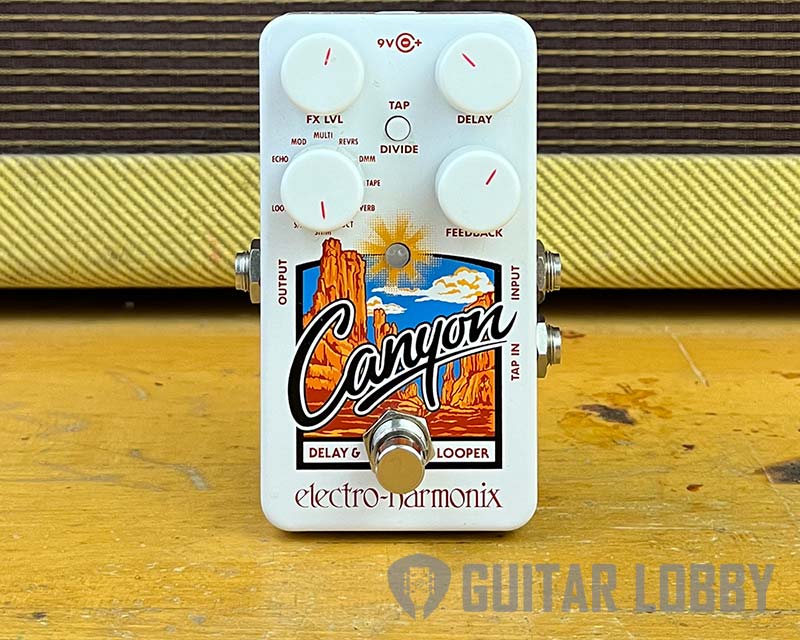
| Estimated Price | $175 |
| Type | Digital |
| Max Delay Time | 600 Ms |
| Effects | Delay, Looper |
| Connectivity | 2 x 6.35mm Jack Input, 1 x Output |
| Power | 9 Volts DC |
If you’re into effects pedals, you’ve probably heard of Electro-Harmonix. I’m a long-term admirer of this brand, as it has been responsible for some of the most innovative pedals ever made. EHX has used its decades of sound-sculpting knowledge to create the excellent Canyon delay and looper pedal, and I couldn’t wait to test it out. It didn’t take me long to realize just how capable this compact stompbox is, and in typical Electro-Harmonix fashion, it goes above and beyond what you’d expect from a pedal its size.
Featuring a collection of ten unique sounding effects, the Canyon gives you complete control over the delay sounds produced by your guitar. I was slightly skeptical about the fact that it includes ten different effects, all based around delay, as sometimes quantity can come at the expense of individual quality. However, my initial apprehension quickly alleviated when I went through each preset one by one.
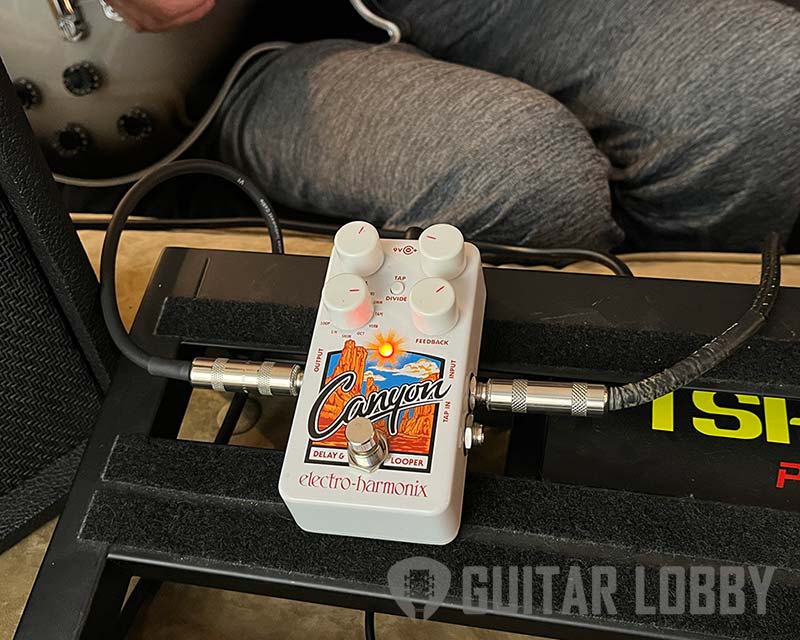
The effect types included on the pedal are echo, modulated, multi-tap, reverse, deluxe memory, tape, reverb plus delay, octave, shimmer, and looper mode. My personal favorite to use is the tape delay. When applied to my electric guitar’s clean tone, this effect coats it in vintage warmth, enhancing the impact of every note that is played. When I’m looking for a more extreme, penetrative guitar tone, I like to use the reverb plus delay preset and switch to my neck pickup. As you can see, Electro Harmonix has packed this pedal full of every variation of delay imaginable, so I’d recommend taking the time to toggle through the presets with the selector knob to take note of how each variation affects your tone.
I could spend a long time praising the delay effects of this pedal, but the looping capability of the Canyon needs to be mentioned, as in my experience, this is the feature that takes this EHX stompbox to the next level. With 62 seconds of looping time, I’ve found this feature incredibly useful for songwriting and composing. Simply choose the length of your loop, then record in whatever you like. This is a great way to work on a melody for a chord sequence you have written, or you can use it to create a wall of atmospheric delay sounds.
I’d recommend this pedal to any guitarist due to the wide range of sounds it can produce. If you play psychedelic music, the Canyon is a must-have pedal. The reverse delay control and the added reverb make it perfect for dreamy, off-center guitar melodies.
Bottom Line: You can expect ultimate quality with an Electro-Harmonix pedal, and the Canyon Delay and Looper once again cements their position in the top tier of FX pedal manufacturing. It’s the kind of pedal that once you have it, you wonder how you coped when it wasn’t part of your pedalboard!
Popular Related Article: Top 17 Delay Pedals
8. TC-Electronic Flashback Delay
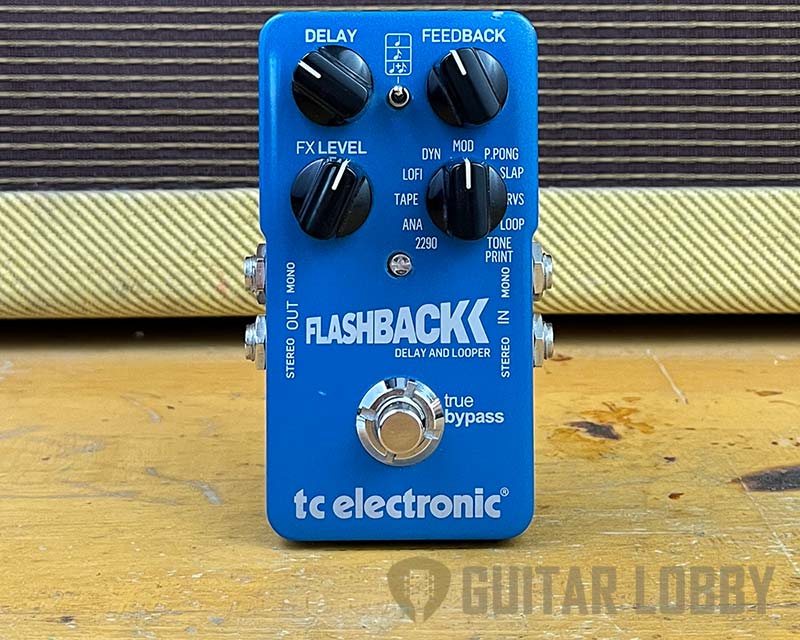
| Estimated Price | $150 |
| Type | Digital |
| Max Delay Time | 6 Seconds |
| Effects | Delay, Looper, Modulation |
| Connectivity | 2 x 6.35mm Jack Input, 2 x Output |
| Power | 9 Volts DC |
I’m always excited to get my hands on a stompbox from renowned effects pedal manufacturers TC-Electronic, and their Flashback Delay left me very impressed. I was intrigued to find that this digital pedal has 11 classic delay types in its arsenal, which is remarkable considering its size. After plugging my guitar into its input and playing it through my amp’s clean channel, I discovered that the pedal covers all of the classic sounds of days gone by, along with some more modern, processed variations of delay. My favorite preset is the warm-sounding tape delay, which sounds great when combined with enough gain to cause my tube amp to break up slightly. I also love using the emulations of the iconic 2290 delay machine when I’m looking for a ’60s rock sound.
In addition to the many effects presets, I like the fact that this pedal also has built-in audio tapping. Unlike the standard type of tap tempo that I’ve previously touched upon in this article, audio tapping gauges the tempo from the strums on your guitar. I’ve found that the advantage of this is that if the tempo drifts mid-song, you can quickly activate this setting, strum in time with the drummer, and you didn’t even miss a beat.
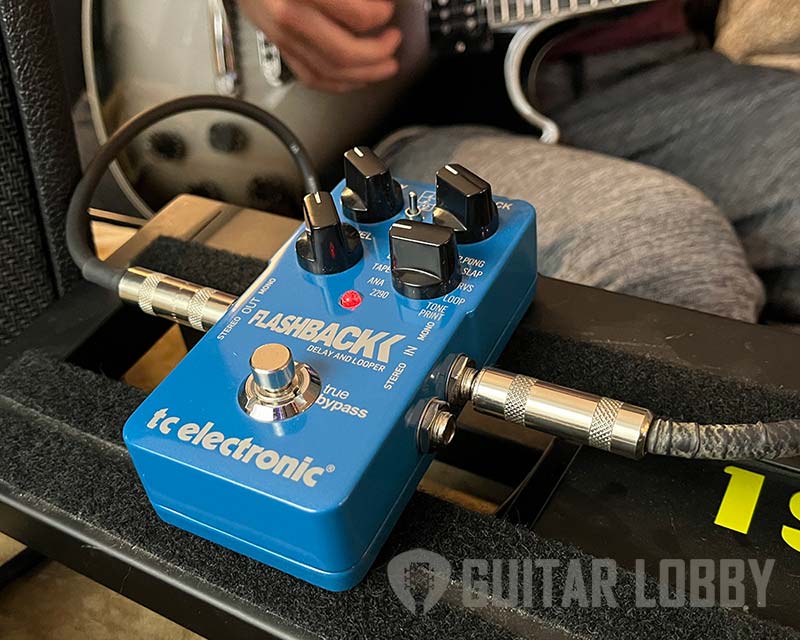
As we’ve come to expect with a TC-Electronics pedal, you can make several other digital variations to the effects in a straightforward and simple manner. Each of the three delay subdivisions has a quarter note, dotted eighth note, and combination settings which I’ve found great for creating trippy rhythmic delays, perfect for atmospheric music or dreamy pop. There’s no need to worry about digital noise, thanks to the true bypass, which ensures that none of the high-end is lost when you turn the pedal off.
The delay time on this pedal goes up to 7 seconds so that you can create everything from old-school slapback to seemingly endless echoes. I’d highly recommend this stompbox to those musicians who love to experiment to find their desired sound. With all of the options available, the Flashback Delay could become overwhelming for people to simply plug in, turn on the pedal, and play. But if, like me, you enjoy figuring out new sounds and exploring the world of audio processing, this pedal is a fantastic option.
Bottom Line: There really are no limitations on what this pedal can produce. You could simply use the provided presets or mess around until you find some crazy sound that’s never been produced before. For a mid-priced pedal, TC-Electronics have included a lot of features you’d expect from a more expensive option. It’s, without a doubt, one of the best delay pedals out there.
9. Strymon El Capistan Tape Echo
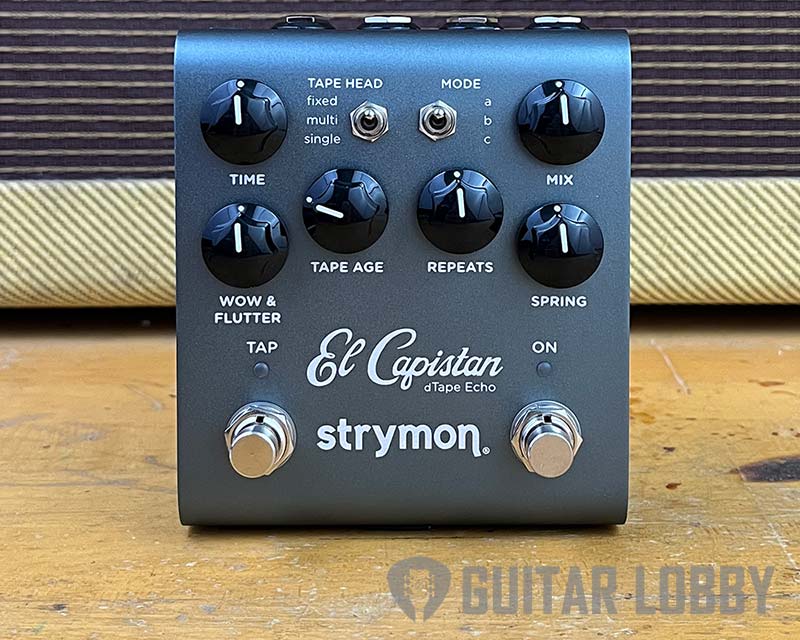
| Estimated Price | $380 |
| Type | Digital |
| Max Delay Time | 620 ms |
| Effects | Delay |
| Connectivity | 2 x 6.35mm Jack Input, 2 x Output |
| Power | 9 Volts DC |
Strymon describes the El Capistan Tape Echo as a “magnetic monster, ” referring to the years of study that went into this hand-crafted pedal. I’d have to agree with that description – this pedal is frighteningly good! After spending long periods in the Strymon sound design labs trying to capture the saturated, distinctive details of classic tape echo machines, they finally settled on the SHARC DSP processing power, which I believe is the key to the exceptional performance of the El Capistan.
This extensive research period resulted in three variations of tape machines installed into the pedal. Of the three modes, my personal favorite is the middle option, labeled “b.” When combined with the “fixed” tape head setting, I found this preset delivers a truly stunning form of vintage delay that even the finest VST plugins I use in my DAW would struggle to come close to.
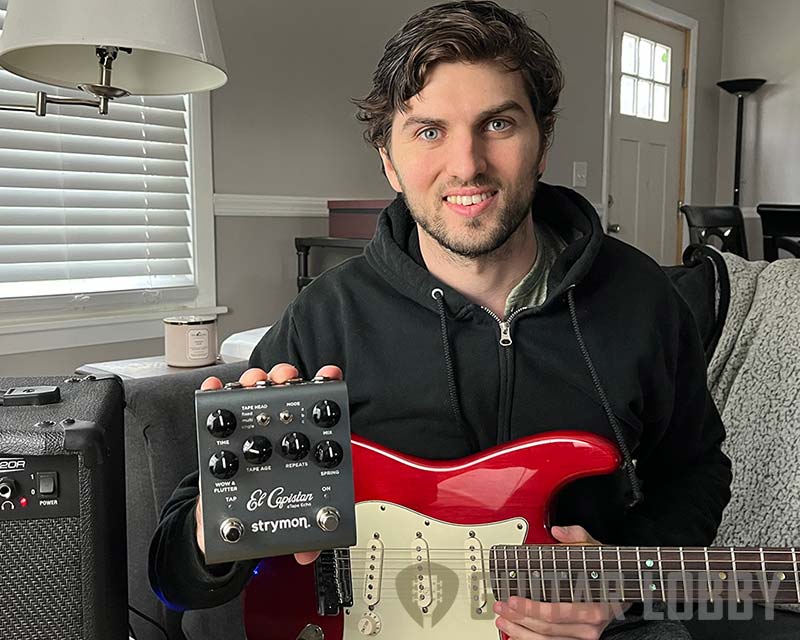
With a total of ten adjustable parameters, you have full control over the tape quality, tone shaping, and machine health settings. When I want to add clear, studio-quality tape echo to my guitar, I like to use the “single” tape head preset, set the mode to “a,” and reduce the Wow & Flutter parameter down to around 25%. This results in a clean, transparent delay that can easily be merged with other intense effects on my pedalboard. When I want to recreate the sound of a vintage, worn-out tape, the El Capistan’s Tape Age knob works perfectly. The DSP driver ensures that each sound is authentic and realistic.
I love the inclusion of “Sound on Sound,” which further emulates an original tape machine by recording the audio and then allowing you to choose the length of the delay before triggering it back out through your amplifier. All of this is controlled by two buttons, so you don’t need to get down to the pedal’s level to utilize the effects. Since its origination in 2008, Strymon has quickly established itself as a leading producer of high-end effects – and they’ve also quickly become one of my favorite boutique pedal brands. I think fans of original tape machines and guitarists who want to produce a lo-fi, vintage sound will love this device. This pedal can give you modern-sounding delays, but it’s best suited to the retro worn-out tape sound, which is popular in garage rock.
Bottom Line: You can tell that a large amount of care, research, and thought went into the design of the El Capistan pedal. It looks the part and does an incredible job of reproducing the exact delay sounds associated with primitive tape machines.
10. Boss DM-2W
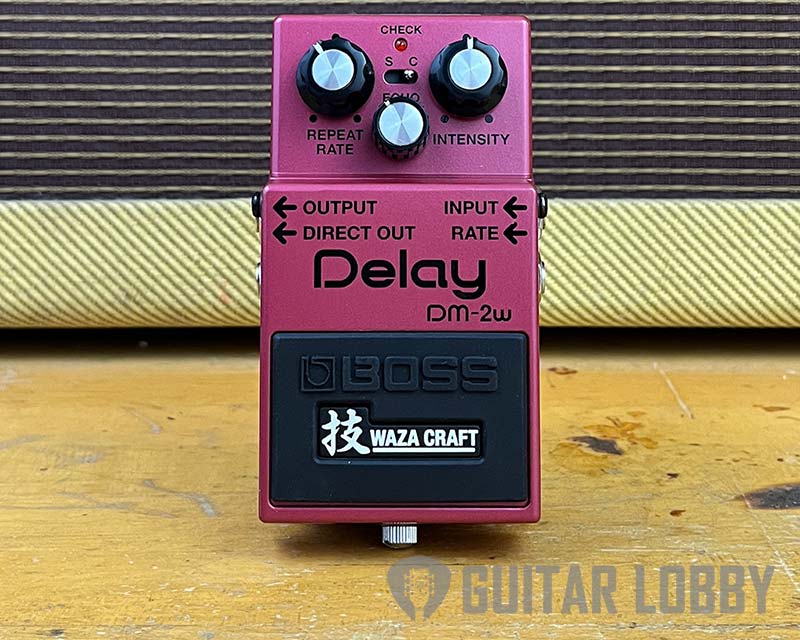
| Estimated Price | $180 |
| Type | Analog |
| Max Delay Time | 800ms |
| Effects | Delay |
| Connectivity | 2 x 6.35mm Jack Input, 2 x Output |
| Power | 9 Volts DC |
I’ve heard a lot about the iconic DM-2 analog delay pedal that enjoyed brief success before its production was discontinued in 1984. Many guitarists have been craving the unique sound the pedal delivered, leading to the originals selling for considerable price tags. Therefore, the prospect of testing the Waza Craft DM-2W, which is somewhat of a remake of the classic DM-2, excited me a lot. The first thing I liked about the pedal was its simplicity – once again, Boss proves that you don’t need many switches, knobs, and buttons to get high-quality, customizable effects. In terms of its sound, I was amazed at how good the delay that comes from this pedal is.
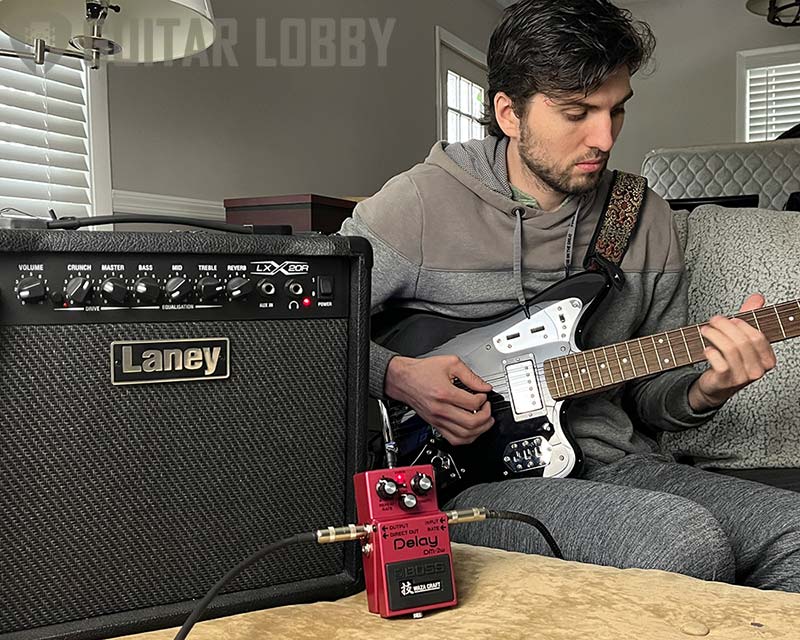
Some of the delay pedals I’ve used in the past, particularly those of the analog variety, have changed the tonal aspects of my guitar too much for my liking – but not the Waza Craft DM-2W. It adds a slight warmth to the tone, but this is a desirable amount rather than overpowering. I love the sound this pedal creates when it is combined with one of my vintage tube amplifiers, and it also sounds great with a little spring reverb sprinkled into the mix. Offering up to 800ms of delay time, this pedal is capable of creating any variety of vintage analog delay.
Bottom Line: This remake of the 1977 DM-2 delay pedal is a must-have for those fond of vintage tape delay and analog gear. Its range of high-quality sounds and simple design make it one of my favorite delay pedals to use when I want to get set up quickly.
| Name of Product | Image of Product | Description | Price Range | Full Review |
|---|---|---|---|---|
| 1. MXR-M169 Carbon Copy Analog Delay | 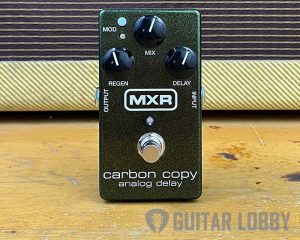 | Type: Analog Max Delay Time: 600 Ms | $150 | Read Full Review Above |
| 2. Wampler Metaverse | 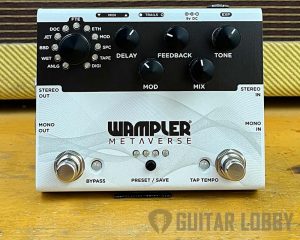 | Type: Digital Max Delay Time: 2000 ms | $300 | Read Full Review Above |
| 3. Keeley Halo Dual Echo | 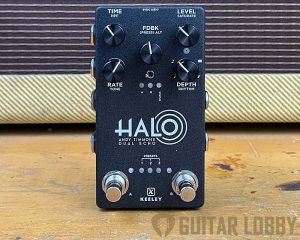 | Type: Digital Max Delay Time: 1.5 sec | $300 | Read Full Review Above |
| 4. Dunlop EP103 Echoplex | 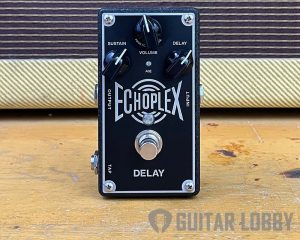 | Type: Digital Max Delay Time: 750 ms | $200 | Read Full Review Above |
| 5. Empress Echo System | 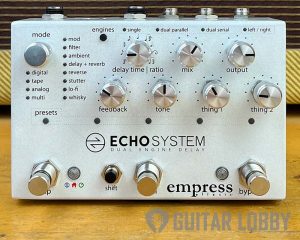 | Type: Digital Max Delay Time: 10 min | $500 | Read Full Review Above |
| 6. TC Echobrain | 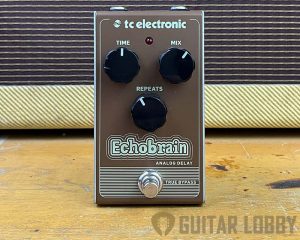 | Type: Analog Max Delay Time: 300 ms | $70 | Read Full Review Above |
| 7. Electro-Harmonix Canyon | 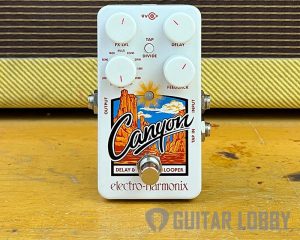 | Type: Digital Max Delay Time: 600 Ms | $175 | Read Full Review Above |
| 8. TC-Electronic Flashback Delay |  | Type: Digital Max Delay Time: 6 Seconds | $170 | Read Full Review Above |
| 9. Strymon El Capistan Tape Echo | 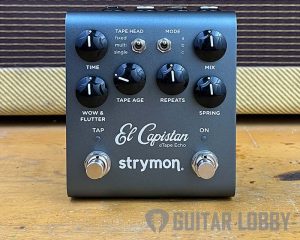 | Type: Digital Max Delay Time: 620 ms | $380 | Read Full Review Above |
| 10. Boss DM-2W | 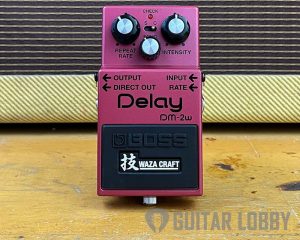 | Type: Digital Max Delay Time: 800 ms | $180 | Read Full Review Above |
Choosing the Right Guitar Delay Pedal (Buying Guide)
Why should you add a delay pedal to your pedalboard? Well, there are multiple reasons. Delay pedals are great for thickening your tone when you set the delay time to be short lasting. They create a double-tracked effect when used in this way, giving you a more full-bodied output. Alternatively, you can use long delay times to create psychedelic or ambient tones, and there are many other options in between these two extremes. If you want the option of beefing up your tone, building suspense, or adding some vintage tape delay to your guitar output, you’ve come to the right place.
As you can see from our comprehensive list, delay pedals vary greatly in terms of their aesthetics, capabilities, and features. I understand that some of the terms used to describe the different variations of delay can be confusing, so in the guide below I will go over the main aspects of delay pedals so that you have all the information required to choose the best suited option for your needs.
Analog vs. Digital Pedals
Delay pedals come in two varieties: analog and digital. Which is better? Well, that ultimately comes down to personal preference. Both of these types of delay pedals have their respective strengths and limitations, so it’s important to establish what it is that you’re looking for before making a purchase.
Let’s start with analog pedals. Technically speaking, analog delay pedals are usually reliant on a device known as a bucket-brigade. This is a small chip that transmits the analog signal through a number of capacitors at one step for every clock cycle. With each step, the repeated delays become gradually darker and warmer in tone. Many music purists prefer analog delay pedals because of their vintage, authentic sound. One of the downsides to analog is that the maximum delay times are generally shorter than their digital counterparts, due to the limitations of the bucket-brigade chips.
Digital delay pedals work by using digital signal processing chips in order to produce an echo effect. This gives the manufacturers complete dominion over the abilities of the delay pedal, such as the minimum and maximum length, transparency, and overall color. The main advantage of digital delay pedals is that they offer more options than those of an analog variety. The sound is more processed than analog, but some guitarists feel that this is a worthy tradeoff for the numerous options that digital provides.
Whether analog or digital delay pedals are the better choice is a subjective matter. If you’re looking for a vintage, warm sounding delay and don’t require dramatic presets then analog is probably the right choice for you. However, if you need flexibility, precision, and more extreme forms of delay, then digital will likely suffice.
The Different Types of Delay
Delay has been used as an effect ever since recording music became a possibility. From the pre-digital days of tape delays to more modern, processed varieties, there is a multitude of delay types that are commonly featured on pedals. I’ll explain some of the most common kinds, what they are used for and the effect that they produce.
The earliest form of delay used for recording was tape delay, which originated when rock n’ roll was in its infancy back in the 1950s. Recording engineers would capture audio onto machines using magnetic tape reels. The recordings would be played back on the tape strips which resulted in a naturally occurring delay. Eventually, analog tape delay would be emulated by digital machines like delay pedals.
Still to this day many musicians and producers prefer to use tape delays in their recordings due to their authentic, vintage sound. Digital delay pedals come very close to reproducing analog tape delay, but there is an undeniable charm associated with the original method which still sounds great decades after its discovery.
Slapback Echo delay is another popular variety that is commonly featured on delay pedals. This type of delay has a distinctive punch to it, due in large to its quick attack and short sustain. It’s similar to the echo you get in a large room and was made famous by artists like Elvis Presley. On a modern digital delay pedal, slapback echo can be achieved by turning down the feedback control and cranking the delay control up. This provides a short, sharp delay, thickening the sound.
Another popular type of delay that you may come across on a pedal is looping delay. You’ve probably seen artists using a looper to track multiple instruments and create a full production before your eyes. These loop delay pedals work in the same way as all other forms of delay – by receiving audio then playing it back retrospectively. By doing this, you can create multiple loops which can then be internally stored in the memory of the pedal to be triggered later.
Doubling echo is another popularly featured variety on delay pedals. This form of delay has similar characteristics to slapback echo, the only difference being that its delay time is shorter. This produces a double track effect, which is commonly used on vocals to iron out any blemishes in pitch or strengthen the overall tone. When used with a guitar via a delay pedal, doubling echo thickens the sound.
Digital multi-delays are the most popular variety among guitarists today. They usually feature a mixture of emulations of the classic delay sound I previously mentioned, but the advantage of a digital pedal is this you get complete control over the characteristics of the delay. Many of these pedals are compatible with USB so you can connect to a computer and tweak their settings within your preferred DAW. Purists would argue that digital delay will never come close to the original analog sound, but in terms of flexibility, they’re hard to beat.
Tap Tempo
You’ll find that many delay pedals have a function known as tap tempo. This means you can hook the pedal up to a footswitch and tap in time with a song, so that each repeat of the delay is synchronized in timing with what you’re playing.
A common issue with pedals that don’t have built-in tap tempo is that your delay can drift out of time with the tempo of the song you’re playing. The reason some delay pedals don’t have this function built-in is that it takes up a considerable amount of space on the pedal. The way around this issue is to tweak the delay time manually on your pedal, but the downside to this is that you can’t use the same effect across multiple songs like you could with a tap tempo.
Which Type Of Delay Pedal Should You Buy?
Now that you’ve learned the basics about delay pedals, you might be wondering which particular ones will produce the sounds you’re looking for. In the section below, I will advise you on what types of delay pedals will provide your desired results. The commonly produced sounds by delay pedals are:
- Vintage Delay Pedals
- Ambient Delay Pedals
- Slapback Delay Pedals
- Rhythmic Delay Pedals
- Soloing Delay Pedals
If you want to produce vintage delay from your effects pedal, you ideally need one which is of the analogue variety. It is possible to get those classic tones from some digital models too, but ensure that it has a tape echo unit. The main characteristic of vintage, analog delay is that the cycles gradually degrade with each repetition, giving it a warm overall feel. This thickens up the overall sound of a band and makes this type of delay a popular choice among guitarists.
Ambient delay pedals should come with a disclaimer – you may lose many hours of your life sitting in a trance experimenting with the psychedelic sounds they create. The most effective way to produce this type of delay is by choosing a pedal which also facilitates reverb. Basically, the more effects you can combine with the delay, the more ambient sounds you will come across. There’s nothing more fun than playing around with modulation controls create otherworldly sounds from your amp.
I previously described the characteristics of slapback delay, now we’ll discuss how to produce it with a pedal. The simplest way to do this is by shortening the delay time so that the sound repeats almost instantaneously. It’s then important to turn up the overall delay level so that there’s minimal volume difference between the original clean audio and the delay. The feedback setting should be turned down so that sound isn’t repeated multiple times. Most delay pedals have the facilities to create slapback using this method.
One of the most effective ways to utilize delay is by creating rhythmic sounds with it. In order to do this, you’ll need a pedal with tap tempo so that the delay stays locked in with the timing of a song. There are a variety of delay pedals which allow you to create more complex rhythms, rather than just your standard quarter or sixteenth notes. Most rhythmic delay pedals are digital, as they need to process the patterns your program in.
If you’re like me, then the main reason you want a delay pedal is to take your guitar solos to the next level. An effective way to cut through the mix when soloing is by adding a touch of delay with a short sustain, as this creates a doubling effect and beefs up your tone. Alternatively, you might be more interested in creating a beautiful mess when soling. By this, I mean adding longer delays so that each note plays back and gradually fades out. This is a great technique to use when you are playing a more intimate solo, and most delay pedals will have the ability to produce this sound. Learn more about types of audio delay here.
Controls and Parameters
There are a staple set of controls and parameters included on nearly all delay pedals. These are:
- Effect Level
- Delay Time
- Feedback
The effect level is pretty self-explanatory. It’s basically the amount of delay you want to allow to be added to the signal. Much like a wet/dry control, this allows you to add or remove the effect from your overall sound.
The delay time affects the duration that the repeated signal lasts for. For example, if you were to turn the delay time all the way up, you would increase the amount of time between playing a note on your guitar and the repeated or delayed version being reproduced.
The feedback parameter controls the amount of delay that is produced. It essentially determines how long the sustain of the repeated note occurs, so if you wanted the delay to be more subtle, you would turn down the feedback control and vice versa.
Multi-Effects Pedals
Many multi-effects pedals have delay built-in, as you will have seen on the list at the top of this article. The advantage of multi-effects pedals is that they combine all of your effects into one hub, saving space on your pedalboard and making it easier to quickly toggle through each setting. The majority of these pedals have effects like chorus, reverb, phase, flange, modulation, and others installed.
A word of warning however, multi-effects pedals don’t usually provide you with the detailed controls that you would find on a pedal that is exclusively for delay. Due to the multitude of effects available, the options available to you will most likely be reduced, so if you’re looking solely for a delay pedal it’s probably best to overlook one which has a combination of audio processing options and instead choose a more specific model.
Signal-Chain Placement
One of the common questions regarding any effects pedals is where should you position them in the chain? There’s no definitive answer to this, as you may find that sometimes accidental placement creates interesting and unique tones. However, there are a few rules of thumb that will make sure you get the best out of your delay pedal.
Commonly, guitarists will position dirt before delay. If you use overdrive, distortion, or fuzz, these pedals should be placed before your delay pedal in the chain as this means that the distorted signal is affected by the delay so there’ no risk of the sound becoming muddy. Distortion pedals have the biggest impact on your signal, so putting delay before them would create a mess. To reiterate, you might be searching for weird and wonderful sounds so feel free to disregard my advice and tear up the rulebook, after all, that’s what many of the most innovative guitarists have done!
Connectivity and Signal Splitting
A number of the delay pedals that featured on our list have what is called dual-outputs. Why would you need two outputs? Well, let’s say you play in a three-piece band with one guitar, a bass, and drums. Or a two piece with just a drummer and guitarist. The chances are you’re going to want to add some more body to your guitars tone in order to fill the space adequately.
A great way to do this is by using two amplifiers. A pedal with two outputs allows you to split the signal and have a dry version playing through one amp and the manipulated signal playing through another. This is useful because it means that the dry, clean version of what you are playing carries on even when you use your delay pedal or other effects, giving you an overall beefier sound and avoiding losing power when you switch your pedals on.
Preset Saving
Saving presets allows you to fine-tune your delay settings then store them within the pedal’s memory so that you can easily access them again. Not all delay pedals have this capability, but there is a good number that do. When you combine a preset saving pedal with a footswitch, this is where the magic really starts to happen. You can save all of your favorite delays into the pedal, then toggle through them using the switch for seamless transitions on stage without the need to bend over and handle the pedal.
Reverse Delay
One of the most interesting types of delay which is commonly found on a pedal is reverse delay. This is created by passing the input signal through a memory buffer which delays it for a short time and then sends the reversed signal back to the output to create a trippy effect.
Powering Your Delay Pedal
The majority of delay pedals run off 9 volt DC power, with some able to be powered by a battery. If you plan on setting up multiple pedals, I would recommend considering a power pack. This is basically an electronic hub that has multiple powered outputs of varying voltages.
Power packs are particularly useful because they can be fixed permanently to your pedal board, so all you need to do is plug it into the mains and all of your pedals are ready to go. There are lots of options out there, but in order to get the right one, you need to determine the number of pedals that require powering.
Trusting the Manufacturer
With so many options on the market and new manufacturers popping up all over the place, it’s important to choose one with a history of producing high quality pedals. I’ve fallen victim to some cheap alternatives which have stopped working after a short period of use before, simply because I didn’t research whether the brand had a solid reputation.
All of the pedals I listed earlier in this article are, in my opinion, solid and reliable choices. I hope that the information provided has helped you to determine which type of delay pedal is best suited to your needs. All that’s left to do now is enjoy the process of experimenting with your new pedal. I hope it brings you many hours of satisfaction and helps you improve your songwriting and performing!

My name is Chris and I’ve had a passion for music and guitars for as long as I can remember. I started this website with some of my friends who are musicians, music teachers, gear heads, and music enthusiasts so we could provide high-quality guitar and music-related content.
I’ve been playing guitar since I was 13 years old and am an avid collector. Amps, pedals, guitars, bass, drums, microphones, studio, and recording gear, I love it all.
I was born and raised in Western Pennsylvania. My background is in Electrical Engineering, earning a Bachelor’s degree from Youngstown State University. With my engineering experience, I’ve developed as a designer of guitar amplifiers and effects. A true passion of mine, I’ve designed, built, and repaired a wide range of guitar amps and electronics. Here at the Guitar Lobby, our aim is to share our passion for Music and gear with the rest of the music community.
